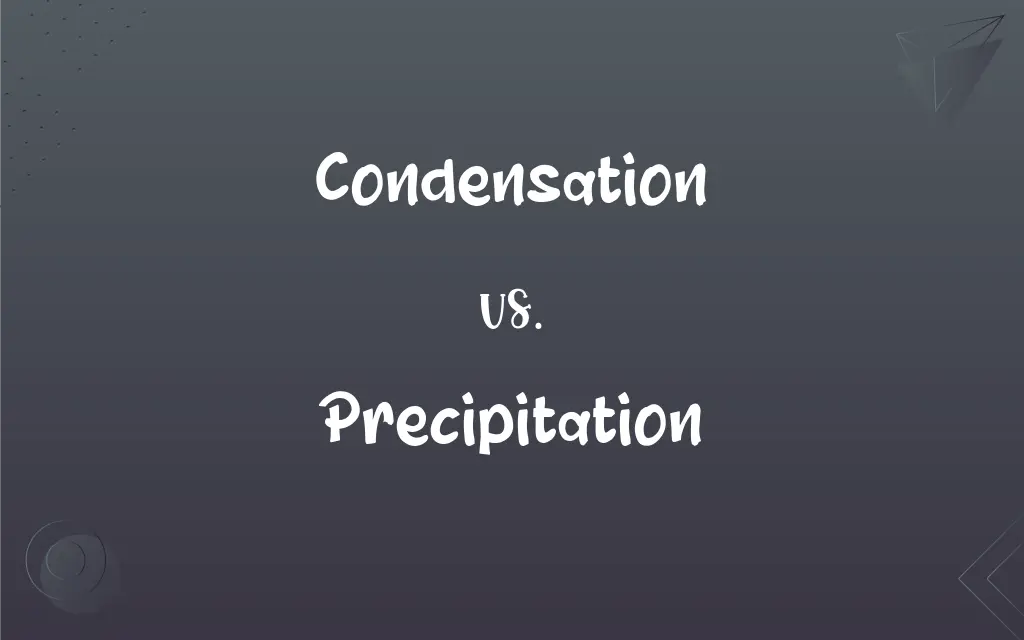Condensation vs. Precipitation: What's the Difference?
Edited by Janet White || By Harlon Moss || Published on January 16, 2024
Condensation is the process of water vapor turning into liquid water, while precipitation is the falling of water from clouds to the Earth's surface in forms like rain, snow, or hail.

Key Differences
Condensation involves a phase change from gas to liquid, as water vapor in the air cools and becomes liquid water. It's a key part of the water cycle, contributing to cloud formation. Precipitation occurs when water droplets or ice crystals in clouds become heavy enough to fall to the ground. It includes rain, snow, sleet, and hail, playing a crucial role in distributing water across the Earth's surface.
Condensation often occurs at or near the Earth's surface, visible on surfaces like grass or windows, especially in the morning or in cooler climates. It can also occur at higher altitudes forming clouds. Precipitation, on the other hand, happens when condensed water in clouds falls due to gravity, requiring specific atmospheric conditions like temperature and air currents.
Condensation is visible as droplets on cold surfaces, fog, or mist. It's noticeable when warm, moist air meets cooler surfaces. Precipitation is visible as it falls from clouds and impacts the Earth's surface, essential for replenishing water bodies, agriculture, and affecting weather patterns.
Condensation is often observed on a smaller scale and can be a localized phenomenon. Precipitation can cover large areas and last from minutes to days, significantly influencing the environment and climate.
Condensation is observed in everyday life, like on a cold beverage glass, and is a key concept in meteorology and climatology. Precipitation is measured using tools like rain gauges and is a major focus in weather forecasting and climate studies.
ADVERTISEMENT
Comparison Chart
Phase Change
Gas (water vapor) to liquid.
Cloud droplets or ice crystals falling to ground.
Occurrence
Near surface, on objects; forms clouds.
From clouds to the Earth's surface.
Visibility and Form
Droplets on surfaces, fog, mist.
Rain, snow, sleet, hail falling from clouds.
Environmental Role
Part of water cycle, cloud formation.
Distributing water across Earth's surface.
Measurement and Impact
Observed in daily life; climatology study.
Measured for weather forecasting; environmental impact.
ADVERTISEMENT
Condensation and Precipitation Definitions
Condensation
Condensation is the process of water vapor turning into liquid.
Condensation formed on the window on a cold morning.
Precipitation
Precipitation is a key part of the water cycle.
Precipitation replenishes our rivers and lakes.
Condensation
Condensation occurs when humid air cools.
The bathroom mirror fogged up due to condensation after a hot shower.
Precipitation
Precipitation includes rain, snow, sleet, and hail.
The city experienced its first snow, a form of precipitation, this winter.
Condensation
Condensation contributes to cloud formation.
The clouds in the sky result from condensation of water vapor.
Precipitation
Precipitation varies in intensity and duration.
Light precipitation in the form of drizzle continued throughout the day.
Condensation
Condensation is visible as droplets on cooler surfaces.
Dew on grass is a clear sign of condensation overnight.
Precipitation
Precipitation is measured for weather analysis.
Meteorologists recorded an inch of precipitation overnight.
Condensation
Condensation happens in various everyday situations.
Condensation on the outside of a cold drink is common in summer.
Precipitation
Precipitation is water falling from clouds to the Earth's surface.
The weather forecast predicted heavy precipitation tomorrow.
Condensation
The act of condensing.
Precipitation
Any form of water, such as rain, snow, sleet, or hail, that falls to the earth's surface.
Condensation
The state of being condensed.
Precipitation
The quantity of such water falling in a specific area within a specific period.
FAQs
What causes condensation?
Cooling of water vapor into liquid.
How is precipitation formed?
From condensed water in clouds falling due to gravity.
What are the types of precipitation?
Rain, snow, sleet, and hail.
Does precipitation only occur as rain?
No, it also includes snow, sleet, and hail.
Where does condensation commonly occur?
On cool surfaces and in the atmosphere.
Is fog a form of condensation?
Yes, fog is a result of condensation.
Is condensation visible?
Yes, as droplets on cold surfaces or as fog.
Is condensation a daily occurrence?
Yes, in various forms like dew and fog.
Can precipitation occur without clouds?
No, it forms within clouds.
What impacts does precipitation have?
It affects water supply, agriculture, and weather patterns.
Can precipitation be artificially induced?
Yes, through cloud seeding.
How do meteorologists measure precipitation?
Using instruments like rain gauges.
What determines the form of precipitation?
Atmospheric conditions like temperature.
Does condensation contribute to humidity?
It's involved in humidity cycles but doesn't directly increase it.
Do all forms of precipitation provide fresh water?
Mostly, except for saltwater forms like sea spray.
Can condensation lead to precipitation?
Yes, it contributes to cloud formation, which can lead to precipitation.
How does precipitation affect climate?
It influences local and global climate patterns.
Does condensation always form droplets?
Mostly, but it can also form a thin film of moisture.
Why does condensation happen on cold drinks?
Due to the cooling effect on humid air around the drink.
Is condensation important for the water cycle?
Yes, it's essential for cloud formation.
About Author
Written by
Harlon MossHarlon is a seasoned quality moderator and accomplished content writer for Difference Wiki. An alumnus of the prestigious University of California, he earned his degree in Computer Science. Leveraging his academic background, Harlon brings a meticulous and informed perspective to his work, ensuring content accuracy and excellence.
Edited by
Janet WhiteJanet White has been an esteemed writer and blogger for Difference Wiki. Holding a Master's degree in Science and Medical Journalism from the prestigious Boston University, she has consistently demonstrated her expertise and passion for her field. When she's not immersed in her work, Janet relishes her time exercising, delving into a good book, and cherishing moments with friends and family.






































































